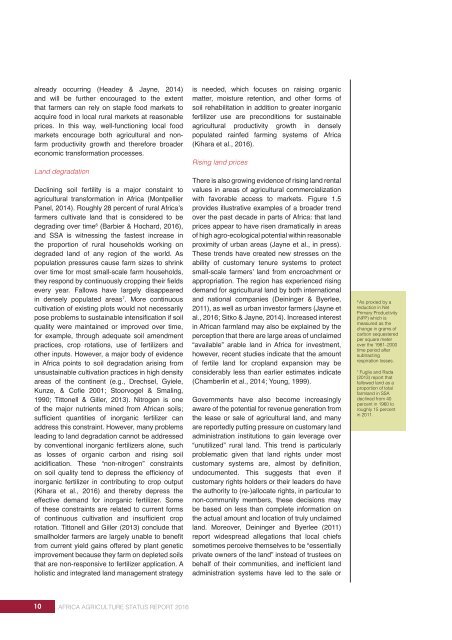AFRICA AGRICULTURE STATUS REPORT 2016
AASR-report_2016-1
AASR-report_2016-1
Create successful ePaper yourself
Turn your PDF publications into a flip-book with our unique Google optimized e-Paper software.
already occurring (Headey & Jayne, 2014)<br />
and will be further encouraged to the extent<br />
that farmers can rely on staple food markets to<br />
acquire food in local rural markets at reasonable<br />
prices. In this way, well-functioning local food<br />
markets encourage both agricultural and nonfarm<br />
productivity growth and therefore broader<br />
economic transformation processes.<br />
Land degradation<br />
Declining soil fertility is a major constaint to<br />
agricultural transformation in Africa (Montpellier<br />
Panel, 2014). Roughly 28 percent of rural Africa’s<br />
farmers cultivate land that is considered to be<br />
degrading over time 6 (Barbier & Hochard, <strong>2016</strong>),<br />
and SSA is witnessing the fastest increase in<br />
the proportion of rural households working on<br />
degraded land of any region of the world. As<br />
population pressures cause farm sizes to shrink<br />
over time for most small-scale farm households,<br />
they respond by continuously cropping their fields<br />
every year. Fallows have largely disappeared<br />
in densely populated areas 7 . More continuous<br />
cultivation of existing plots would not necessarily<br />
pose problems to sustainable intensification if soil<br />
quality were maintained or improved over time,<br />
for example, through adequate soil amendment<br />
practices, crop rotations, use of fertilizers and<br />
other inputs. However, a major body of evidence<br />
in Africa points to soil degradation arising from<br />
unsustainable cultivation practices in high density<br />
areas of the continent (e.g., Drechsel, Gyiele,<br />
Kunze, & Cofie 2001; Stoorvogel & Smaling,<br />
1990; Tittonell & Giller, 2013). Nitrogen is one<br />
of the major nutrients mined from African soils;<br />
sufficient quantities of inorganic fertilizer can<br />
address this constraint. However, many problems<br />
leading to land degradation cannot be addressed<br />
by conventional inorganic fertilizers alone, such<br />
as losses of organic carbon and rising soil<br />
acidification. These “non-nitrogen” constraints<br />
on soil quality tend to depress the efficiency of<br />
inorganic fertilizer in contributing to crop output<br />
(Kihara et al., <strong>2016</strong>) and thereby depress the<br />
effective demand for inorganic fertilizer. Some<br />
of these constraints are related to current forms<br />
of continuous cultivation and insufficient crop<br />
rotation. Tittonell and Giller (2013) conclude that<br />
smallholder farmers are largely unable to benefit<br />
from current yield gains offered by plant genetic<br />
improvement because they farm on depleted soils<br />
that are non-responsive to fertilizer application. A<br />
holistic and integrated land management strategy<br />
is needed, which focuses on raising organic<br />
matter, moisture retention, and other forms of<br />
soil rehabilitation in addition to greater inorganic<br />
fertilizer use are preconditions for sustainable<br />
agricultural productivity growth in densely<br />
populated rainfed farming systems of Africa<br />
(Kihara et al., <strong>2016</strong>).<br />
Rising land prices<br />
There is also growing evidence of rising land rental<br />
values in areas of agricultural commercialization<br />
with favorable access to markets. Figure 1.5<br />
provides illustrative examples of a broader trend<br />
over the past decade in parts of Africa: that land<br />
prices appear to have risen dramatically in areas<br />
of high agro-ecological potential within reasonable<br />
proximity of urban areas (Jayne et al., in press).<br />
These trends have created new stresses on the<br />
ability of customary tenure systems to protect<br />
small-scale farmers’ land from encroachment or<br />
appropriation. The region has experienced rising<br />
demand for agricultural land by both international<br />
and national companies (Deininger & Byerlee,<br />
2011), as well as urban investor farmers (Jayne et<br />
al., <strong>2016</strong>; Sitko & Jayne, 2014). Increased interest<br />
in African farmland may also be explained by the<br />
perception that there are large areas of unclaimed<br />
“available” arable land in Africa for investment,<br />
however, recent studies indicate that the amount<br />
of fertile land for cropland expansion may be<br />
considerably less than earlier estimates indicate<br />
(Chamberlin et al., 2014; Young, 1999).<br />
Governments have also become increasingly<br />
aware of the potential for revenue generation from<br />
the lease or sale of agricultural land, and many<br />
are reportedly putting pressure on customary land<br />
administration institutions to gain leverage over<br />
“unutilized” rural land. This trend is particularly<br />
problematic given that land rights under most<br />
customary systems are, almost by definition,<br />
undocumented. This suggests that even if<br />
customary rights holders or their leaders do have<br />
the authority to (re-)allocate rights, in particular to<br />
non-community members, these decisions may<br />
be based on less than complete information on<br />
the actual amount and location of truly unclaimed<br />
land. Moreover, Deininger and Byerlee (2011)<br />
report widespread allegations that local chiefs<br />
sometimes perceive themselves to be “essentially<br />
private owners of the land” instead of trustees on<br />
behalf of their communities, and inefficient land<br />
administration systems have led to the sale or<br />
6<br />
As proxied by a<br />
reduction in Net<br />
Primary Productivity<br />
(NPP) which is<br />
measured as the<br />
change in grams of<br />
carbon sequestered<br />
per square meter<br />
over the 1981–2000<br />
time period after<br />
subtracting<br />
respiration losses.<br />
7<br />
Fuglie and Rada<br />
(2013) report that<br />
fallowed land as a<br />
proportion of total<br />
farmland in SSA<br />
declined from 40<br />
percent in 1960 to<br />
roughly 15 percent<br />
in 2011.<br />
10 <strong>AFRICA</strong> <strong>AGRICULTURE</strong> <strong>STATUS</strong> <strong>REPORT</strong> <strong>2016</strong>


